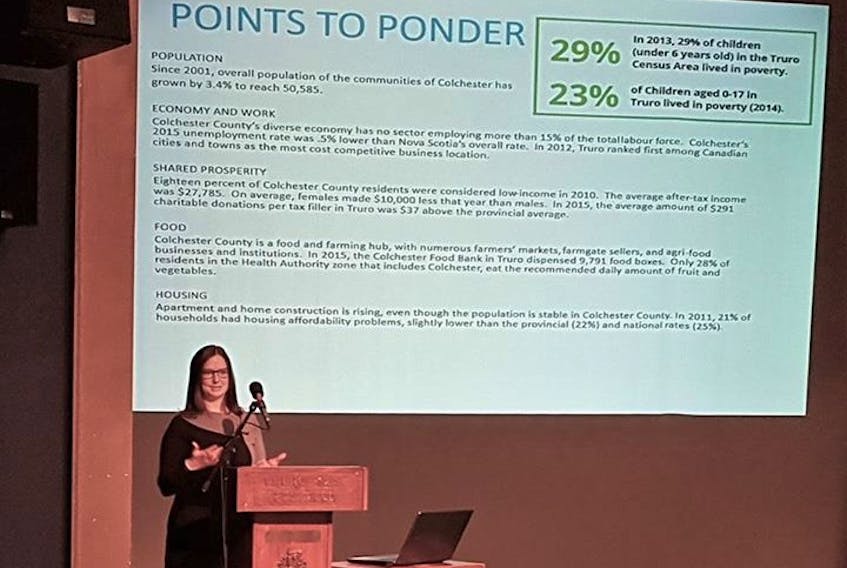TRURO, N.S.
The fact that 23 per cent of children in Colchester County are living in poverty was one of the things that stood out for those involved in putting together the Colchester Communities Vital Signs report.
The report, designed to measure the vitality of the community and identify significant trends, and compiled through collaboration between the Community Foundation of Nova Scotia (CFNS) and the United Way of Colchester County (with input from groups and individuals), was released to the public Thursday morning.
“We will be taking this report, digesting it and then coming back to have conversations in January around ‘How do we use this information to drive our strategic direction?’” said Keltie Jones, chair of the board for the United Way of Colchester County. “How do we make sure that the decisions we’re making around funding are going to move the needle on some of the most distressing facts that are in here? Because some of the facts are distressing and they’re things that we don’t want our community to look like.”
She challenged those who attended the launch of the report to take the information back to their organizations and use it to see what they can do to make positive change.
“It (the report) talks about some things we’re doing really well and it talks about some things that are not going so well, and they are not two separate topics; they’re connected,” she said. “We need to really leverage the opportunities we’ve created for ourselves: the thriving economy, the growing population, the fantastic facilities…. We need to leverage those things to move the needle on some of these other issues. We need to make sure that everyone in our communities has the opportunity to participate in our economy.”
The report addresses population, food, transportation, housing, safety, belonging, health and wellness, learning, environment, arts and culture, economy and work, recreation, and shared prosperity.
Karis Mitchell, the CFNS project co-ordinator, noted that 2011 statistics were often used because the most recent national information was released shortly after the report was written.
“The report is filled with opportunities and catalyst for change that can be used by the members of the communities of Colchester,” she said. “It doesn’t have to be people who hold high positions; it can be community members who have a desire to recognize the changes that are necessary and utilize the report.”
Terry Hearn, executive director with the United Way of Colchester County, said she hopes the report will be a catalyst that leads to steps that create healthier communities.
“Our decision to lead a Vital Signs project came out of discussions with donors, volunteers and stakeholders who identified a need for information, a Colchester Snapshot,” she said.
The report will be available on the Community Foundation of Canada website within a couple of weeks. Printed copies are available through the United Way of Colchester County.
The report is the major piece of the Vital Signs initiative, which was funded by the United Way of Colchester, Town of Truro, Municipality of Colchester, Town of Stewiacke, Central Nova Women’s Resource Centre and the Community Foundation of Nova Scotia. The five local partners contributed a total of $10,750 and that was matched by the foundation. Remaining funds may be used to build a community fund or support initiatives that strengthen the community.

Points from the report
Truro and Colchester County combined had a 36 per cent decrease in the crime rate between 2010 and 2016.
93 per cent of residents rely on cars for transportation.
In 2014, 65 per cent of Colchester County residents reported having very good mental health.
Between 2001 and 2016 Colchester County and Halifax were the only areas to see a population increase. Most came from other provinces.
In 2014, 19 per cent of those in Truro were considered low income. The provincial rate is 18 per cent. The rate of children living in low-income families was 23 per cent, the second highest in the province (Cape Breton having a rate of 33 per cent).
31 per cent of Northern Zone (which includes Colchester County) residents self reported as having a body mass index over 30, which is considered obese. This was the second highest rate in Canada (Cape Breton was highest at 34 per cent).









